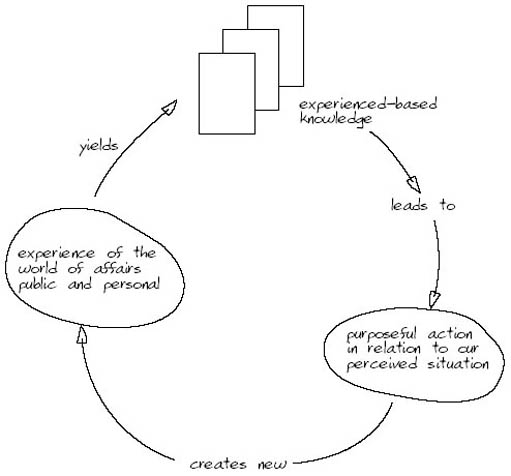5.3 Purposeful and purposive behaviour
It is possible, as observers, to ascribe a purpose to what we or others do, the actions we take. How particular actions, or activities are construed will differ from observer to observer because of their different perspectives, which arise from their traditions of understanding. For example, in Figure 38 the person cutting the stone may ascribe their purpose as cutting stone or building a cathedral. It is for this reason that I will ask you to adopt several different stakeholder perspectives in answering Activity 48.

Even if we do not ascribe purposes to our own actions, another observer may infer our purposes by observing our actions and their outcomes, so that in their eyes we implicitly have a purpose to our actions. Ascribing purpose is an important process in taking a systems approach to managing complexity. It also raises the question as to whether there is any relationship between what an observer can distinguish when he or she wishes to claim an overarching goal, a common purpose, a set of shared values, or a common ethic? When I think about these I see little difference, but each term means different things to different people, and each has a particular history of use in different intellectual traditions.
Within systems thinking, purpose is a contested notion. However purpose is always attributed to a system by someone. Within systems practice the attribution of purpose can be a creative, learning process. I am reminded of Peter Checkland's story of working to improve prison management and seeing purpose – and thus system – in terms of ‘rehabilitating criminals’; ‘training criminals’; ‘protecting society’; etc. Stafford Beer said: ‘the purpose of a system is what it does’. But for me this is too constraining as it runs the risk of objectifying ‘the system’. I would rather employ the notion of purpose in a process sense, within the process of inquiry. This would lead me to ask: What might we learn about the situation if we were to think of a prison as if it were a system to train criminals?
For me there is also a risk in reducing the notion of purpose to mean an objective or goal that can be achieved, and in some cases optimised. I make this distinction because the important aspect of systemic practice, compared with systematic practice, is exploring or inquiring of a situation: ‘What would I learn from attributing purpose to this situation?’ Alternatively the question might be posed as ‘In reflection what purpose do I attribute to my own actions in this situation?’
Two forms of behaviour in relation to purpose have also been distinguished. One is purposeful behaviour, which Checkland (1993) describes as behaviour that is willed – there is thus some sense of voluntary action. The other is purposive behaviour – behaviour to which an observer can attribute purpose. Thus, in the example of the government minister, if I described his purpose as meeting some political imperative, I would be attributing purpose to him and describing purposive behaviour. I might possibly say his intention was to deflect the issue for political reasons. Of course, if I were to talk with him I might find out this was not the case at all. He might have been acting in a purposeful manner which was not evident to me.
SAQ 13
Decide which of the following scenarios best exemplify purposefulness or purposiveness.
(a) A group of friends who drink together regularly at the local pub are enthusiastic about football and decide rather than just watching and talking about it they will form their own team. This they do.
(b) Sophie noticed a group of youths running down the street and immediately thought they were responsible for the vandalised telephone kiosk nearby.
(c) My company has adopted the internationally recognised set of environmental management standards, but after a year of working with them we find they are not helpful in our particular circumstances. However, we feel we have to stick with the international standards to maintain credibility.
(d) We learned our customers were dissatisfied with our after-sales support. As a result, we changed our ways of operating; this has had positive effects right through the business.
Answer
Both (a) and (d) exemplify purposefulness because each demonstrate examples of willed action and/or changing behaviour in response to learning. Scenario (b) exemplifies purposiveness – the attribution of purpose by someone outside the context. For me, scenario (c) has elements of both purposefulness and purposiveness. The former is indicated by the phrase, ‘my company has adopted’. Whereas purposiveness is indicated by the way standards are often imposed from the outside in ways that are unhelpful because they are not sensitive to the local situation.
Activity 48
Ascribing purpose and system to your engagement with complexity. Re-examine your answer to Activity 43. What purpose did you attribute to it?
Can you imagine other purposes that might be attributed to it? Take a number of different stakeholder perspectives and list a possible purpose for the CSA from what you think is their perspective.
Following the logic of the purposeful and purposive distinctions, systems that can be seen to have an imposed purpose that they seek to achieve are called purposive systems and those that can be seen to articulate their own purpose(s) as well as seek them purposeful systems. This reminds me of the story of the rock and the bird used before in relation to the label ‘complex adaptive systems’.
One of the key features attributed to purposeful systems is that the people in them can pursue the same purpose, sometimes called a what, in different environments by pursuing different behaviours, sometimes called a how. Note that I have deliberately not used the term goals, because of the current propensity to see goals as quite narrowly defined objectives. Certainly this was the way they were interpreted in the systems engineering tradition of the 1950s and 1960s and in the traditional OR paradigm (see Tables 5 and 8). Checkland and his co-workers beginning in the late 1960s reacted against the thinking in systems engineering and OR at that time and coined the terms ‘hard’ and ‘soft’ systems. I will discuss this in more detail later.
| The hard systems thinking tradition | The soft systems thinking tradition |
|---|---|
| oriented to goal seeking | oriented to learning |
| assumes the world contains systems that can be engineered | assumes the world is problematical but can be explored by using system models |
| assumes system models to be models of world (ontologies) | assumes system models to be intellectual constructs (epistemologies) |
| talks the language of ‘problem’ and ‘solutions’ | talks the language of ‘issues’ and ‘accommodations’ |
| Advantages | Advantages |
| allows the use of powerful techniques | is available to all stakeholders including professional practitioners; keeps in touch with the human content of problem situations |
| Disadvantages | Disadvantages |
| may lose touch with aspects beyond the logic of the problem situation | does not produce the final answers |
| accepts that inquiry is never-ending |
Some systems practitioners have found the thinking associated with goal-oriented behaviour to be unhelpful when dealing with messes. This has resulted in a move away from goal-oriented thinking towards thinking in terms of learning. Some of these trends are depicted in Table 8.
Peter Senge suggests the key to finding a strategy that energises and focuses an entire enterprise without constraining imagination lies in a deep sense of purposefulness (Senge, 1998). This, I suggest, arises out of a cycle of activity that is described in Figure 39. This is another manifestation of the experiential learning cycle described in Figure 32. If this cycle is completed, the purposeful action can be aimed at intended improvements; improvements that are judged by those who take the action. Those involved in this process learn their way to new understandings of the situation from which decisions about change can be made. Many systems approaches are designed to facilitate this cycle of learning.
If a system is conceptualised as a result of the purposeful behaviour of a group of interested observers, it can be said to emerge out of the conversations and actions of those involved. It is these conversations that produce the purpose, and hence the conceptualisation of the system. What it is and what its measures of performance are will be determined by the stakeholders involved. This process has many of the characteristics attributed to self-organising systems (I shall describe these in the next section).

Sometimes there is no agreement on what the system of interest is or what purpose it is seen to have. This seems to me to be a common occurrence. For example, there is no shortage of experts, organisations, agencies, governments, and so on engaged in the definition and derivation of targets, principles, indicators and standards against which the achievement of the measures of performance of a supposed system might be evaluated, monitored and audited – but little agreement, or even discussion, about purpose. In the UK this can be related to the failures and unintended consequences of policy built around the achievement of imposed targets. In other words many people have a propensity to pursue purposive behaviour that assumes both purpose and measures of performance rather than engaging stakeholders in a dialogue in which purpose is jointly negotiated. This can have unfortunate consequences.
If you have engaged with this unit's activities, I think you have already taken systems approaches. Therefore, you have developed the potential to manage complexity. I say potential, because in this unit you have been participating in a simulation by engaging with the activities. This is a common way to develop practice skills. You have been invited to:
(a) Reflect on your purpose in doing this unit (to begin the process of becoming aware of your being);
(b) Engage with a ‘real world’ situation, the case study, which you could choose to perceive as complex, as a mess;
(c) Use different modelling conventions (diagramming) to explore some aspects of the complexity;
(d) Gain insights into: patterns of structure, interconnection, dynamics, systems and subsystems of interest; the implications of boundary choice; situations where taking control action might be possible by modelling a complex situation;
(e) Identify yourself as a stakeholder in the situation;
(f) Attribute a purpose to some of the interactions in the case-study situation – to regard it as a system to do X – from the perspective of your stake in the child-support issue;
(g) Formulate a description of a system of interest using the phrase: ‘The CSA is a system to …’.
This was a lot to achieve, and if you made some progress on all of these you are off to a good start. You have taken a systems approach. This approach is one that the course team has found from experience works well in the teaching of Systems to undergraduate OU students. It is also the way the Open University's residential course, called TXR248 Experiencing Systems, starts. There are many ways to refine, develop and add to your skills, and you will have the opportunity to do this as the unit progresses.
